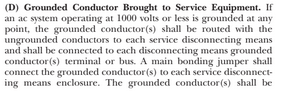MayorMagna01
Electrical
- Feb 22, 2023
- 2
In a 3-phase, 4-wire wye system, such as 208Y/120V system, the neutral conductor is often ground by the utility on the transformer side. It is also a common practice to size and install a grounded conductor from the service entrance connecting transformer's neutral to Main Panel's Neutral Bus Bar to Grounding Electrode.
However, a grounded conductor (on this specific system) is very useful if I have Line-Neutral Loads (120V loads). But what if ALL of my loads are either 208V 3-phase or 208V 1-phase (Line-Line) distributed across each phase..
Your expert opinion will greatly help my young mind to understand better this kind of situations.
Thank you.
However, a grounded conductor (on this specific system) is very useful if I have Line-Neutral Loads (120V loads). But what if ALL of my loads are either 208V 3-phase or 208V 1-phase (Line-Line) distributed across each phase..
1. Do I still need to install a grounded conductor (GC)? If so, why?
2. For North Americans, if I will not going to install GC on this specific scenario, what are my NEC violations?
3. With respect to sizing GC on this specific scenario, is Table 250.102(C)(1) the correct table to use?
Your expert opinion will greatly help my young mind to understand better this kind of situations.
Thank you.

